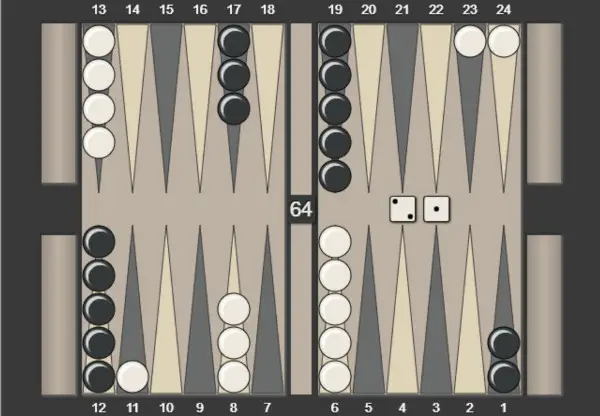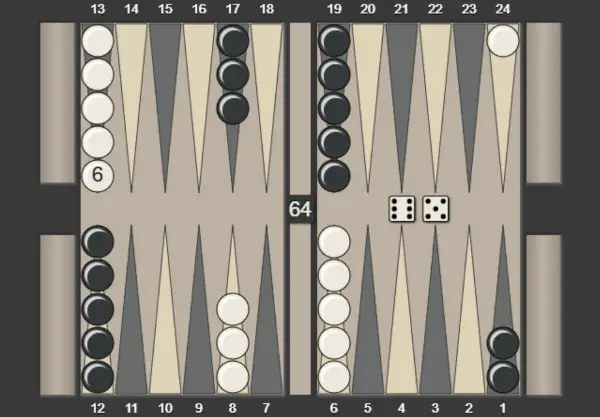Backgammon begins with the opening moves. These initial plays lay the foundation for your entire game, influencing your chances of victory. Mastering the art of opening moves is essential.
What are the best opening moves in backgammon?
Here are some quick links to the 15 possible opening rolls in backgammon and what the best moves are:
Understanding the Basics
Let’s explore the strategies and tactics that will help you dominate the board from the very start. Before diving into specific opening moves, it’s crucial to grasp some fundamental concepts. Backgammon is a game of two halves, with each player racing their checkers around the board to bear them off. Here’s what you need to know:
Checkers’ Starting Positions: In backgammon, you start with 15 checkers in specific positions (see diagram below). Your goal is to move them around the board, hit your opponent’s checkers, and eventually bear your own off the board.

The Role of Dice: Dice rolls determine how many spaces you can move your checkers. Each player has two dice, leading to a wide range of possible moves each turn. To start the game, each player rolls one die. If they both roll the same number, they re-roll until one player rolls a higher number and earns the right to start the game. You can’t therefore start with a double, which means there are 15 possible opening moves.
The Bar: If one of your checkers is hit by your opponent’s checker, it goes to the bar, starting its journey all over again. The bar can be a strategic battleground.
Now, let’s delve into some essential opening strategies:
- The Running Game:
Goal: Start your checkers on a race to your home board as quickly as possible.
Opening Moves: Move your checkers strategically to make a “running game” possible. Focus on moving checkers from your mid-point to your home board, creating opportunities for speedy checkers advancement.
- The Priming Game:
Goal: Create a blockade or “prime” to trap your opponent’s checkers.
Opening Moves: Build a prime by moving your checkers to form a wall. This restricts your opponent’s movement and can lead to powerful control of the board.
- The Blitz Game:
Goal: Aggressively attack and trap your opponent’s checkers.
Opening Moves: Focus on advancing your back checkers and making points in your home board. Be prepared to hit your opponent’s checkers and create a “blitz.”
- The Back Game:
Goal: Create a defensive setup while waiting for your opponent to leave blots.
Opening Moves: Establish anchor points in your opponent’s home board to prepare for the back game. This strategy can be particularly effective when you’re behind in the race.
- The Split and Slot Game:
Goal: Split your back checkers and prepare for potential attacks.
Opening Moves: Move one checker from your mid-point to your opponent’s mid-point, creating a “split.” Simultaneously, create a point in your home board to secure the split checker’s advancement.
- The Balanced Approach:
Goal: Maintain flexibility and adapt your strategy to your opponent’s moves.
Opening Moves: Begin with balanced moves, making both offensive and defensive plays. As the game progresses, adjust your strategy based on your opponent’s moves and the dice rolls.
The opening moves in backgammon set the stage for an exciting and dynamic game. While these strategies provide a solid foundation, remember that adaptability and situational awareness are key. As you gain experience, you’ll learn to read the board, anticipate your opponent’s moves, and craft opening moves that suit your unique style and the current game circumstances.
So, the next time you sit down to play backgammon, approach the opening moves with confidence and strategy. Whether you prefer the running game, priming game, blitz game, or any other style, understanding these fundamental strategies will give you a competitive edge and elevate your backgammon skills to new heights. May your dice roll favorably, and your checkers find their path to victory!
What is the best opening move with 2-1 in backgammon?
With a roll of 2-1, you have a couple of strategic choices to consider for your opening move. One option is to split your back checkers (24/23) while bringing one checker down (13/11):

Alternatively, if you’re in the mood for a more aggressive play, you can opt to slot your 5 (golden) point (6/5) and then move one checker down (13/11):

Click to go back to table of opening moves
What is the best opening move with 3-1 in backgammon?
This roll is considered the best in backgammon. Your optimal move here is to secure your 5 golden) point by moving two checkers (8/5) and (6/5):

It’s crucial to note that for this specific roll, no other moves should be entertained.
Click to go back to table of opening moves
What is the best opening move with 3-2 in backgammon?
With a roll of 3-2, it’s a good idea to consider splitting your back checkers by moving one checker from your 24-point to the 21-point (24/21). Simultaneously, bring one of your mid-point checkers down (13/11):

Click to go back to table of opening moves
What is the best opening move with 4-1 in backgammon?
For a roll of 4-1, you have two viable options. Our preferred move is to split your back checkers (24/23) and bring one down from the midpoint (13/9):

Alternatively, if you’re feeling lucky, you can slot your 5 (golden) point (6/5) and then bring one checker down (13/9):

Click to go back to table of opening moves
What is the best opening move with 4-2 in backgammon?
When you roll a 4-2, the second-best roll in backgammon, the most strategically sound move is to secure your 4-point by moving two checkers (8/4, 6/4):

Click to go back to table of opening moves
What is the best opening move with 4-3 in backgammon?
With a roll of 4-3, there are several acceptable moves to consider. The most favorable choice is to split your back checkers (24/21) and bring down a builder (13/9) to set the stage for forming advanced points on later rolls:

Click to go back to table of opening moves
What is the best opening move with 5-1 in backgammon?
For a 5-1 roll, you have two choices. The safe option is to split your back checkers (24/23) and bring one down from the midpoint (13/8):

Alternatively, if you’re open to a riskier approach, you can slot your 5 (golden) point (6/5) and then move one checker down (13/8):

Click to go back to table of opening moves
What is the best opening move with 5-2 in backgammon?
The move 24/22, 13/8 yields the best results as it splits your back checkers, making them less vulnerable to being hit while positioning them to establish an advanced anchor:

Click to go back to table of opening moves
What is the best opening move with 5-3 in backgammon?
When you roll a 5-3, the optimal move is to secure your 3-point by moving two checkers (8/3, 6/3):

Click to go back to table of opening moves
What is the best opening move with 5-4 in backgammon?
The most favorable option here is to split your back checkers (24/20) and bring a checker down (13/8). This move creates opportunities on both sides of the board.

Click to go back to table of opening moves
What is the best opening move with 6-1 in backgammon?
With a 6-1 roll, the third-best in backgammon, the opening move is to secure your bar point (13/7, 8/7):

Click to go back to table of opening moves
What is the best opening move with 6-2 in backgammon?
By moving 24-18, 13-11 you advance checkers on both sides of the board.

Click to go back to table of opening moves
What is the best opening move with 6-3 in backgammon?
Similar to a 6-2 roll, 24-18, 13-10 is a balanced move for a 6-3 roll, as it also advances checkers on both sides of the board.

Click to go back to table of opening moves
What is the best opening move with 6-4 in backgammon?
The best move for a 6-4 roll is to make a run for it with one of your back checkers (24/14).

Click to go back to table of opening moves
What is the best opening move with 6-5 in backgammon?
Commonly referred to as the “Lovers Leap”, the optimal move for a 6-5 roll is to run one of your back checkers to the midpoint (24/18, 18/13).

Click to go back to table of opening moves
* Backgammon board images created with bgLog


